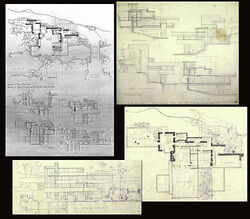| Frank Lloyd Wright's Blueprints of Fallingwater | |
|---|---|

| |
| Some of the schematics | |
|
Origin |
Frank Lloyd Wright/Fallingwater |
|
Type |
6 Blueprints |
|
Effects |
Can create holograms of any building |
|
Downsides |
Water will appear around the user |
|
Activation |
Unrolling and thinking of a building |
|
Collected by |
Agent Brady Brown |
|
Section |
|
|
Date of Collection |
Aug.21.2014 |
| [Source] | |
Origin[]
Frank Lloyd Wright (June 8, 1867 – April 9, 1959) was an American architect, interior designer, writer, and educator, who designed more than 1,000 structures, 532 of which were completed. Wright believed in designing structures that were in harmony with humanity and its environment, a philosophy he called organic architecture. This philosophy was best exemplified by Fallingwater (1935), which has been called "the best all-time work of American architecture". Wright was a leader of the Prairie School movement of architecture and developed the concept of the Usonian home, his unique vision for urban planning in the United States.
Fallingwater, or the Kaufmann Residence, is a house designed by Frank Lloyd Wright in 1935 in rural southwestern Pennsylvania, 43 miles (69 km) southeast of Pittsburgh. The home was built partly over a waterfall on Bear Run in the Mill Run section of Fayette County, Pennsylvania. The house is considered one of the most beautiful buildings in the U.S.A, and a masterpiece of architecture.
Effect[]
When any of the blueprints are unrolled, they create a 3D hologram of any building the user thinks of. The holograms are highly detailed, and can be manipulated to however the user wants. If left unrolled for too long, the water will begin to appear around the blueprints. The blueprints can work either separately or together.
